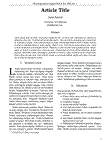Resultados de búsqueda - ((((olor OR plo) OR olote) OR (lot OR (lote OR (date OR (water OR mateo))))) OR (blot OR blost))*
Materias dentro de su búsqueda.
Materias dentro de su búsqueda.
- shrimp 7
- México 5
- Shrimp 4
- color 4
- nutrition 4
- Artículo 3
- Mexico 3
- biodiversidad 3
- calidad 3
- escasez de agua 3
- quality 3
- water scarcity 3
- 2
- Adsorción 2
- Bacteria, yeast, single cell proteins, attractants, fish meal replacement, shrimp feeds 2
- C61 2
- DPPH 2
- Gobernanza 2
- Governance 2
- Historia ambiental 2
- Infraestructura 2
- Nocturna para Trabajadores 2
- Nuevo León 2
- Pacific white shrimp 2
- Preparatoria No. 3 2
- Q25 2
- Sustainability 2
- Sustentabilidad 2
- Tilapia 2
- Tourism 2
-
1
Lot production size problem and simulation of urban transport
Publicado 2015“…OBJECTIVES AND STUDY METHOD: There are two subjects in this thesis: “Lot production size for a parallel machine scheduling problem with auxiliary equipment” and “Bus holding for a simulated traffic network”. …”
Enlace del recurso
Tesis -
2
Lot production size problem and simulation of urban transport
Publicado 2015“…OBJECTIVES AND STUDY METHOD: There are two subjects in this thesis: “Lot production size for a parallel machine scheduling problem with auxiliary equipment” and “Bus holding for a simulated traffic network”. …”
Enlace del recurso
Tesis -
3
-
4
-
5
Diseño de aderezos empleando harina de olote obtenida como subproducto agrícola.
Publicado 2022“…El maíz es un alimento muy importante en México, un subproducto agrícola que se genera en el proceso de separación del grano de la mazorca es el olote. El uso del olote ha estado muy restringido debido a la dificultad que existe para acceder a sus componentes (carácter recalcitrante) e incompleta caracterización química. …”
Enlace del recurso
Artículo -
6
-
7
Requirements for the culture of the Pacific white shrimp, Litopenaeus vannamei, reared in low salinity waters: water modification and nutritional strategies for improving production
Publicado 2010“…Requirements for the culture of the Pacific white shrimp, Litopenaeus vannamei, reared in low salinity waters: water modification and nutritional strategies for improving production…”
Enlace del recurso
Artículo -
8
-
9
-
10
Obtención y caracterización químico-nutricia de harinas de olote de maíz en etapa R3 (masoso)
Publicado 2019“…Se obtuvieron tres harinas de olote de maíz en etapa R3 (masoso), crudo (T1), cocido con grano y posteriormente desgranado (T2) y cocido sin grano (T3). …”
Enlace del recurso
Artículo -
11
-
12
Xylem water potentials of native shrubs from northeastern Mexico
Publicado 2011“…Xylem water potentials (C) were evaluated in browse plants such as Forestiera angustifolia (Oleaceae), Celtis pallida (Ulmaceae), Zanthoxylum fagara (Rutaceae), and Eysenhardtia texana (Fabaceae). …”
Enlace del recurso
Artículo -
13
Water, endangered fishes, and development perspectives in arid lands of Mexico
Publicado 1994Enlace del recurso
Artículo -
14
Detoxification of Aflatoxin-Contaminated Maize by Neutral Electrolyzed Oxidizing Water
Publicado 2015“…The effectiveness of neutral electrolyzed oxidizing water (NEW) on aflatoxin detoxification was investigated in HepG2 cells using several validation methodologies such as the 3-(4,5-dimethylthiazol-2-yl)-2,5- diphenyltetrazolium bromide assay, the induction of lipid peroxidation, the oxidative damage by means of glutathione modulation, the Ames test and the alkaline Comet assay. …”
Enlace del recurso
Artículo -
15
Computer simulations of confined colloidal systems at the air/water interface
Publicado 2002Enlace del recurso
Artículo -
16
Bromate and chromate removal from water by double layered hydroxides
Publicado 2015“…To remove bromate and chromate from water, common methods include ion exchange, coagulation-flocculation processes, reductionprecipitation, etc., but these strategies can present some important disadvantages like incomplete removal, high cost, continuous use of reagents, and high energy costs. …”
Enlace del recurso
Tesis -
17
Bromate and chromate removal from water by double layered hydroxides
Publicado 2015“…To remove bromate and chromate from water, common methods include ion exchange, coagulation-flocculation processes, reductionprecipitation, etc., but these strategies can present some important disadvantages like incomplete removal, high cost, continuous use of reagents, and high energy costs. …”
Enlace del recurso
Tesis -
18
Considerations for Litopenaeus vannamei Reared in Inland Low Salinity Waters
Publicado 2019“…Considerations for Litopenaeus vannamei Reared in Inland Low Salinity Waters…”
Enlace del recurso
Artículo -
19
-
20



